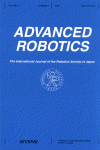
Safe and Compliant Guidance by a Powered Knee Exoskeleton for Robot-Assisted Rehabilitation of Gait
Keywords: PHYSICAL HUMAN-ROBOT INTERACTION; PNEUMATIC MUSCLES; POWERED KNEE EXOSKELETON; PROXY-BASED SLIDING MODE CONTROL; ROBOT-ASSISTED GAIT REHABILITATION
Document Type: Research Article
Affiliations: 1: Robotics & Multibody Mechanics Research Group, Department of Mechanical Engineering, Vrije Universiteit Brussel, Pleinlaan 2, 1050 Brussels, Belgium; Advanced Rehabilitation Technology & Science, Vrije Universiteit Brussel, Pleinlaan 2, 1050 Brussels, Belgium 2: Advanced Rehabilitation Technology & Science, Vrije Universiteit Brussel, Pleinlaan 2, 1050 Brussels, Belgium; Department of Human Physiology & Sports Medicine, Vrije Universiteit Brussel, Pleinlaan 2, 1050 Brussels, Belgium 3: Advanced Rehabilitation Technology & Science, Vrije Universiteit Brussel, Pleinlaan 2, 1050 Brussels, Belgium; Department of Experimental Anatomy, Vrije Universiteit Brussel, Laerbeeklaan 103, 1090 Brussels, Belgium 4: Robotics & Multibody Mechanics Research Group, Department of Mechanical Engineering, Vrije Universiteit Brussel, Pleinlaan 2, 1050 Brussels, Belgium; Advanced Rehabilitation Technology & Science, Vrije Universiteit Brussel, Pleinlaan 2, 1050 Brussels, Belgium 5: Robotics & Multibody Mechanics Research Group, Department of Mechanical Engineering, Vrije Universiteit Brussel, Pleinlaan 2, 1050 Brussels, Belgium
Publication date: 01 March 2011
- Access Key
- Free content
- Partial Free content
- New content
- Open access content
- Partial Open access content
- Subscribed content
- Partial Subscribed content
- Free trial content